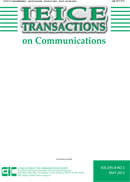All issues

Volume E94.B, Issue 1
Displaying 51-52 of 52 articles from this issue
Regular Section
-
Seigo NAKAO, Kenji TAKAGI, Masaru FUKUOKA, Daichi IMAMURA, Hidekazu MU ...Article type: LETTER
Subject area: Terrestrial Wireless Communication/Broadcasting Technologies
2011 Volume E94.B Issue 1 Pages 364-367
Published: January 01, 2011
Released on J-STAGE: January 01, 2011
JOURNAL RESTRICTED ACCESSAdvanced Evolved Universal Terrestrial Radio Access (Advanced E-UTRA), called LTE-Advanced, has been standardized in the 3rd Generation Partnership Project (3GPP) as a candidate for IMT-Advanced. LTE-Advanced supports spatial orthogonal-resource transmit diversity (SORTD) [1],[2] for ACK/NACK signals and scheduling requests (SRs), which are used to control downlink hybrid automatic repeat requests (HARQs) and manage uplink radio resources based on uplink data traffic, respectively. Both ACK/NACK signals and SRs are carried via a physical uplink control channel (PUCCH) [3], and a common PUCCH format is used for both ACK/NACK signals and SRs. If SORTD is used, the base station assigns mutually orthogonal resources to each antenna included in the user equipment (UE) for ACK/NACK signals and SRs; hence, the number of required resources increases with the number of transmitting antennas in the UE. In this paper, we study the resource reduction method for ACK/NACK signal and SR in case of SORTD using the concept of common resource. In addition, we investigate a phase rotation scheme for common resources to improve the SR detection performance.View full abstractDownload PDF (281K) -
Guolong CUI, Lingjiang KONG, Xiaobo YANG, Jianyu YANGArticle type: LETTER
Subject area: Sensing
2011 Volume E94.B Issue 1 Pages 368-371
Published: January 01, 2011
Released on J-STAGE: January 01, 2011
JOURNAL RESTRICTED ACCESSThis letter mainly deals with the multi-rank signal detecting problem against Spherically Invariant Random Vector (SIRV) background with Invariance theory. It is proved that generalized likelihood ratio test (GLRT), Rao test and Wald test are all the Uniformly Most Powerful Invariant (UMPI) detectors in SIRV distributions under a mild technical condition.View full abstractDownload PDF (86K)